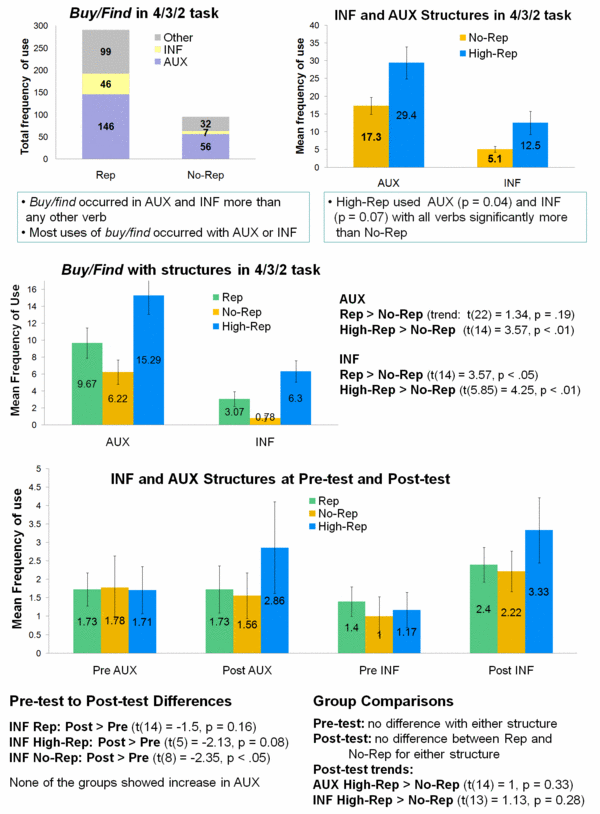Fluency Summer Intern Project 2010
Contents
[hide]Abstract
De Jong & Perfetti (in press) showed that high-intermediate ESL students who repeated a speech on the same topic in 4 minutes, then 3 minutes, then 2 minutes (the “4/3/2 task”) had greater gains in oral fluency on a post-test compared to students who gave their speeches on three different topics. This study investigated whether repetition of the monologues had a long-term effect on the use of grammatical structures.
Twenty-four high-intermediate adult ESL students with mixed L1s were assigned to two conditions (Repetition, No Repetition). They performed three training sessions, and a pre-test, immediate post-test and delayed post-test. Two verbs (buy, find) and two grammatical structures (auxiliary - AUX; infinitive - INF) were selected for analysis. An additional group of high repeaters was analyzed.
Results showed that the High Repetition group repeated buy and find with the grammatical structures more than the No Repetition group. The High Repetition group also used the structures with other verbs more often than No Repetition, and they increased INF use at the post-test.
In conclusion, the 4/3/2 task with repetition may increase the use of the same grammatical structures with repeated words, yielding more practice of the structure. With repetition, high repeaters may have abstracted the structure and used it with different lexical items in the post-test.
Background and significance
De Jong & Perfetti (in press) showed that ESL students who repeated a speech on the same topic in 4 minutes, then 3 minutes, then 2 minutes (the “4/3/2 task”) had greater gains in oral fluency on a post-test compared to students who gave their speeches on three different topics.
There was significant lexical overlap across retellings for the students who repeated the same topic, but the lexical overlap did not transfer to the post-tests. Since fluency gains cannot be attributed to faster lexical access of these specific vocabulary words, it is possible that the repetition of grammatical contexts in which the repeated words occurred is driving these fluency gains.
Oral fluency depends primarily on the proceduralization of declarative linguistic knowledge (Towell, Hawkins, & Bazergui, 1996). Linguistic knowledge becomes proceduralized through repeated practice, such that language knowledge is accessed automatically from long-term memory (Towell et al., 1996). From the constructionist perspective, specific lexical items become associated with certain grammatical constructions (Ellis, 2002) With frequent use, these structures become abstract representations in the speaker’s mind and can generalize to other lexical items (Bybee, 2005).
Research question
- Does repetition of a monologue have a long-term effect on the use of grammatical structures in intermediate ESL learners?
- Does repetition of grammatical structures in the 4/3/2 task lead to increased use of these structures in other contexts?
Method
Participants
24 high-intermediate adult ESL students with mixed L1s
Training
- Repetition (Rep; n = 15): spoke about shopping 3 times
- High-Repetition (High-Rep) AUX (n = 7)
- High-Repetition (High-Rep) INF (n = 6)
- No-Repetition (No-Rep) (n = 9): spoke about shopping, cell phones, television
Tests
2-minute pre-test and post-test speech on different topics
Selection of Words and Structures
Selected common grammatical structures around verbs repeated across deliveries in training session B. Focused analysis to two verbs and their two most common structures:
- Buy (topic related), Find (not topic related)
- Auxiliary Structure (AUX): Auxiliary + buy/find
- Infinitive Structure (INF): Verb + to + buy/find
Independent variables
- Training condition / Frequency of use: Repetition, No Repetition, High Repetition
- Time: Pre-test, post-test
Dependent variables
- Frequency of use in 4/3/2 training session B
- INF
- AUX
- Frequency of use in tests
- INF
- AUX
Hypotheses
- Students in the Repetition condition repeat words across deliveries in the same grammatical structures, and use these words with the structures more than the students in the No Repetition condition.
- Students who repeat these words and their grammatical structures also show increased use of the abstract grammatical structure in the post-test.
Findings
- In the 4/3/2 task, the High Repetition group repeated buy and find with the grammatical structures more than the No Repetition group.
- High Repetition group also used the structures with other verbs more often than No Repetition
- High Repetition increased INF use at the post-test.
Explanation
The 4/3/2 task with repetition may increase the use of the same grammatical structures with repeated words, yielding more practice of the structure. With repetition, high repeaters may have abstracted the structure and used it with different lexical items in the post-test.
Future Analysis
- Temporal fluency measures (pause data) around the grammatical structures
- Accuracy of grammatical structures in pre- and post-test
- Analyze additional grammatical structures
Notes
- Frequency data was limited in the pre- and post-test analysis, since students spoke for only two minutes each, compared to nine minutes total in the 4/3/2 sessions.
- Effects may have been topic-driven . The topics in the 4/3/2 task may have elicited use of certain words or structures that were not elicited by the topics in the pre- and post-test.
Related presentations
Warren, M. (2011). The role of repeated grammatical structures in second language fluency. Paper presented at McGill's Canadian Conference for Linguistics Undergraduates. Montreal, QC, March 2011.
Further information
The data preparation and analysis of this part of the project has been performed by Mariah Warren from Northeastern University (summer intern in June-July 2010), under supervision of Mary Lou Vercellotti and Dr. Laura Halderman from the University of Pittsburgh, and Dr. Nel de Jong from the Free University in Amsterdam. With thanks to Jon-Michel Seman for his contributions to data coding.
This internship was part of the project Fostering fluency in second language learning by Nel de Jong, Laura Halderman, and Charles Perfetti.
